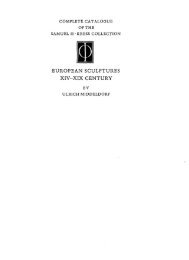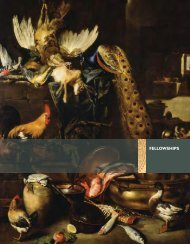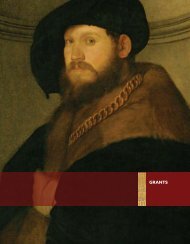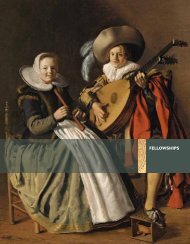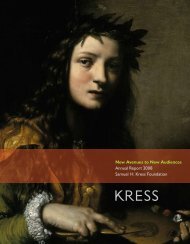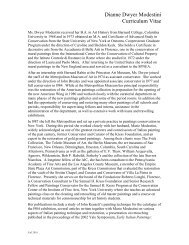The Campus Art Museum - Samuel H. Kress Foundation
The Campus Art Museum - Samuel H. Kress Foundation
The Campus Art Museum - Samuel H. Kress Foundation
Create successful ePaper yourself
Turn your PDF publications into a flip-book with our unique Google optimized e-Paper software.
have an ally in the museum. <strong>The</strong>re was nobody there who does Russian art so<br />
they saw me as a new contribution to their department, not just as a museum<br />
person.<br />
Emails/Letters Targeting Specific Courses<br />
Academic and education curators strategically consider which academic programs<br />
and courses might best be served by the museum’s collections and use targeted<br />
emails or letters to inform deans, department chairs, faculty, and discussion leaders<br />
of the museum’s resources. <strong>The</strong> following quotations describe this process. <strong>The</strong> first<br />
is from the IUAM and the second is from the David and Alfred Smart <strong>Museum</strong><br />
(Smart):<br />
I have just done a massive email outreach to all faculty teaching in the spring,<br />
I think the subject line was “Let us design a gallery session for your course next<br />
semester.” It tells them what a curriculum-structured gallery program is, which<br />
is a gallery session led by our staff… that we design based on the collections<br />
around the professor’s curriculum. Generally, they send me a syllabus. I talk to<br />
them either in person or with a couple of emails about their course themes and<br />
ideas. Often I write back with a list of possible art works to cover and what I’m<br />
envisioning. And generally they write back, “Sounds great, we’ll be there.”<br />
<strong>The</strong>re’s something at the University of Chicago called the core curriculum and<br />
we use that, particularly the humanity core sequences that many first-year<br />
students take…. I’ve reached out to those instructors because these are courses<br />
that are taught in sixteen to eighteen sections in any given quarter…. So we<br />
started focusing on the humanities and reaching out to those instructors and<br />
inviting them to send us syllabi or let us know what themes they are teaching<br />
and [we began] thinking about ways we could connect the collection to those<br />
themes. We made specific proposals for the classes, object packages that they<br />
might consider…. This is getting some momentum, so this is now the second<br />
or third year for some of the sequences…. More recently we’ve reached out to<br />
social sciences as well.<br />
Academic curators and museum educators, particularly at large institutions,<br />
tend to focus on introductory courses that all first-year students take, such as<br />
composition seminars. Languages, literature, anthropology, and art education are<br />
other popular areas, but the reach extends beyond these courses. As described by<br />
an academic curator, museum personnel try “to establish a long-term relationship<br />
with certain departments or professors for those really large classes” so that<br />
particular gallery sessions can be developed and used year after year.<br />
Student Docents/Liaisons<br />
<strong>Campus</strong> art museums that prepare students to serve as docents, create, in the<br />
process, a valuable link between the museum and academic courses. As the<br />
students become familiar with the museum’s resources, they make suggestions to<br />
Attracting Faculty to the <strong>Campus</strong> <strong>Art</strong> <strong>Museum</strong><br />
8



